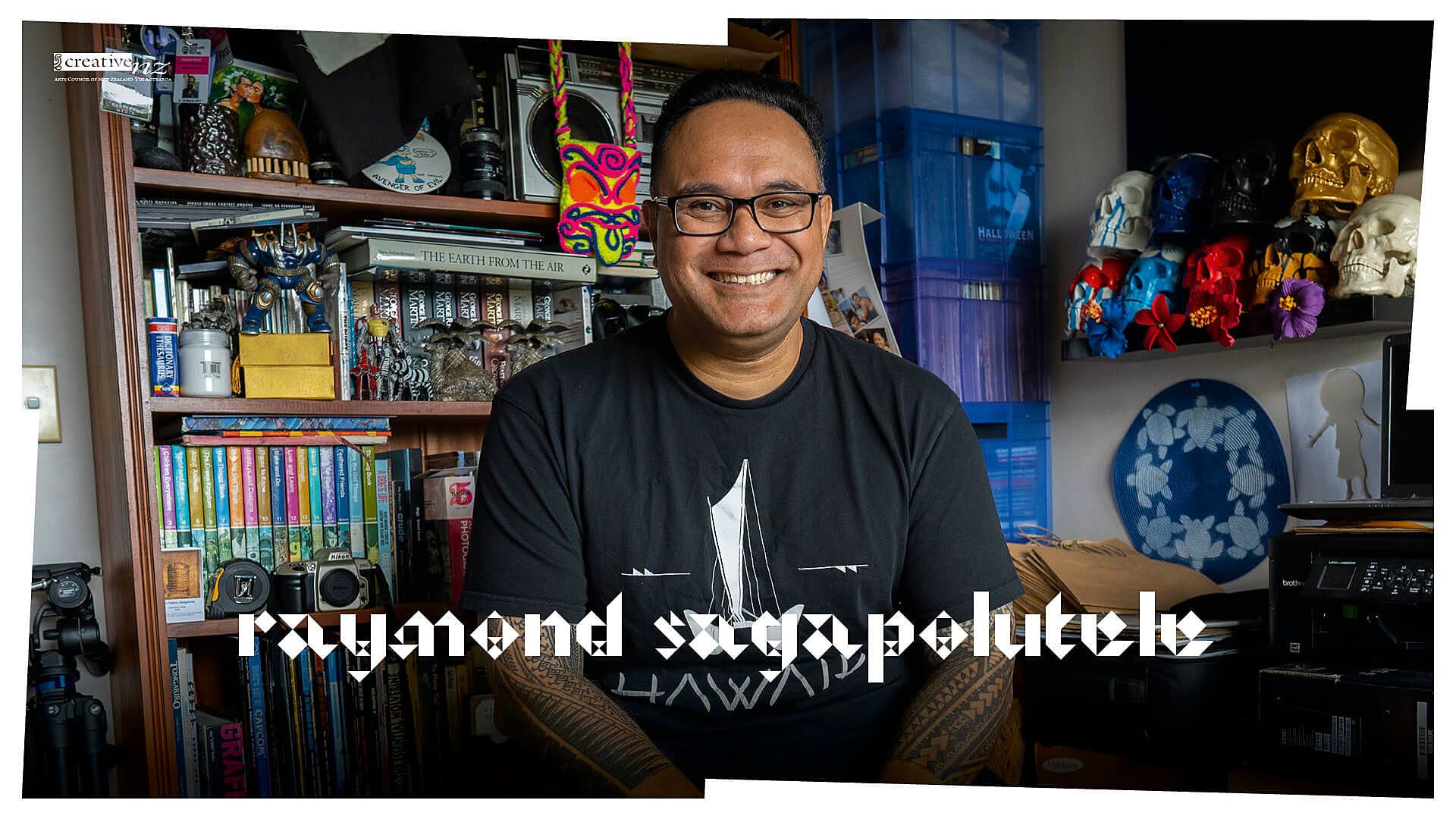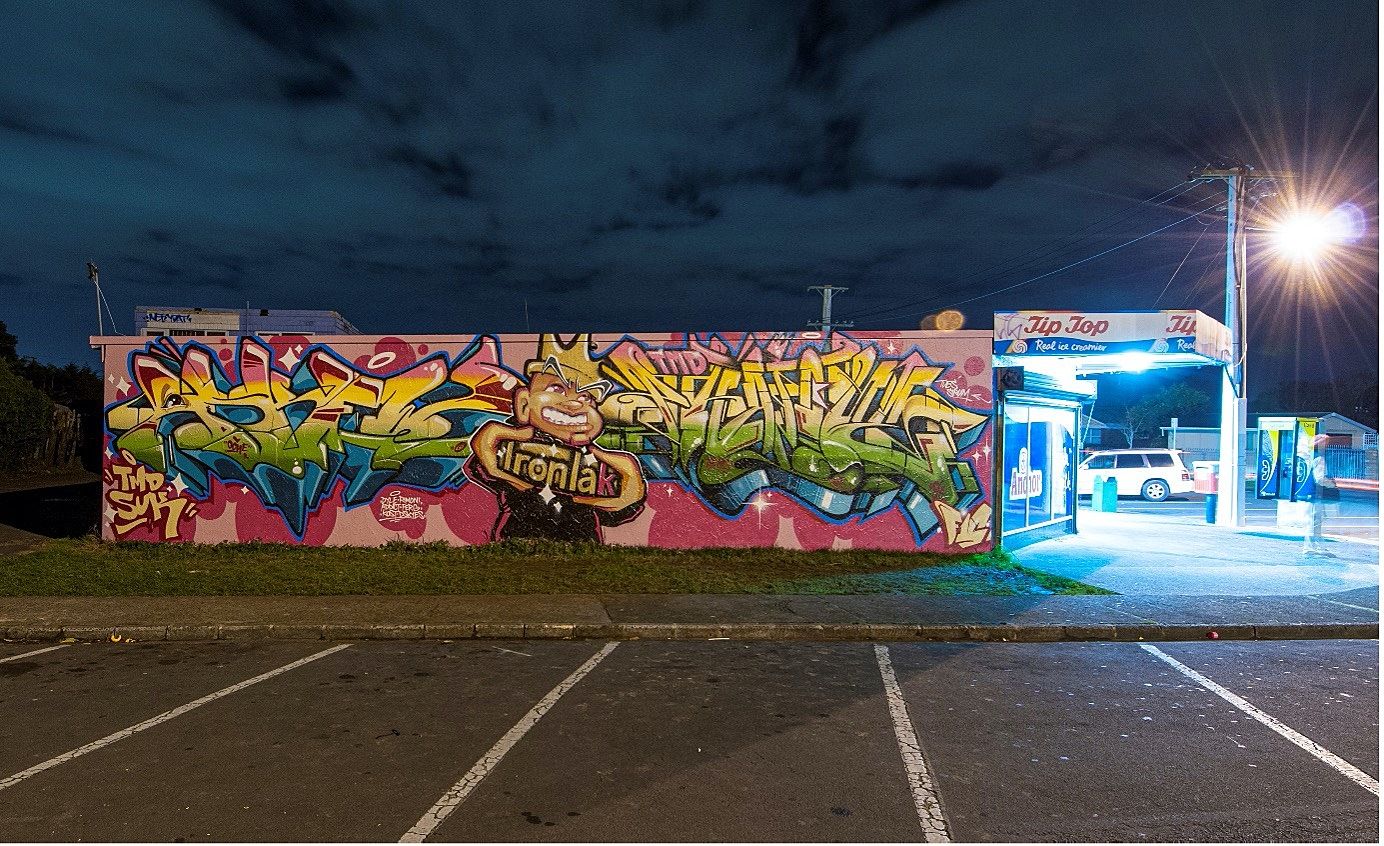Good Times
“Make art and don’t worry about what you think other people want,” was the advice photographer Raymond Sagapolutele’s uncle gave him. Sagapolutele reflects on that mantra in the collective work of The Most Dedicated (TMD).
We’re collaborating with Creative New Zealand to bring you the groundbreaking Pacific Arts Legacy Project. Curated by Lana Lopesi as project Editor-in-Chief, it’s a foundational history of Pacific arts in Aotearoa as told from the perspective of the artists who were there.
In March of this year, I found myself, as usual for my practice, standing in an art gallery and photographing the work on the walls. This time around, though, the art I was documenting is mine and it is sitting alongside the work of my close friends, a collective of artists known as TMD (and occasionally as The Most Dedicated). The walls belong to The Dowse Art Museum in Lower Hutt and the story we are telling is around how our collective was founded, and our evolution as artists and, more importantly for me, a family.
TMD roll-call by Benjamin Work, The Dowse Art Museum, 2021, Raymond Sagapolutele.
For myself, it’s a great way to mark another chapter in our journeys as artists who have been part of an ever-evolving collective that in many ways sits outside of most mainstream visual arts circles. From my early days frequenting internet forums like phunkrepublic and hiphopnz in the early 2000s, and hanging out with Benjamin Work, the younger brother of my wife's best friend (she had told me, “You should meet Ben, he likes the same hippery hoppery rubbish you listen to.” My wife and I have a love and bond forged in opposition to everything we are). From there my love of hip-hop culture, from the music, dance and ultimately its founding visual art form, graffiti, would see me develop my take on the world via my camera.
There was so much to experience and see in those early years of hanging around and travelling with members of TMD, from walls alongside rail lines to small group shows in and around Tāmaki, and more specifically Karangahape Road, that would become fundamental to my burgeoning skills as a photographer. Part of my ability to tell a story through photo documentary developed from seeing and capturing beyond their finished pieces; the intent of much of the work was driven by the character of the writers and I wanted to do them justice by preserving that in the narrative of their art.
TMD, Write for Gold Aotearoa Battle, Karangahape Road, 2006, Raymond Sagapolutele.
Before my time with TMD my worldview of graffiti was informed by the documentary Style Wars and the book Subway Art. Piled on top of that was a local scene in Manurewa during the 90s that for the most part was tags, tag roll-calls, and crude chrome throwies along the rail line from Southmall to Homai. My time as a tagger during this era ended shortly after my dad realised I was the artist responsible for redecorating all the shops he passed on his walk to and from work. Back then the allure of hip-hop culture was huge for kids who felt othered by what was considered mainstream – the freedom to express in a way that allowed us to put up a front and to confront. More so for many of my family and friends, as kids born in the diaspora and away from our parents' home islands. For the most part, it cost us nothing, but among our peers, it gave us everything. The only validation we sought was from those we respected; anyone else who didn’t understand – not our problem. Fast-forward a decade and time spent working hard for my money, and there I am hanging out at walls or in the dark near railway tracks with my friends and getting paint all over my gear. Good times.
Askew One, Plunket Avenue, 2008, Raymond Sagapolutele.
Askew One and Phat1, Ironlak commission, Māngere, 2008, Raymond Sagapolutele.
When I was asked by Charles Williams back in 2008 if I’d be keen to become a part of TMD it came as a surprise – I had not even considered the idea of joining the collective as I wasn’t, well, you know, a graffiti writer. This didn’t matter, for the collective, what was important was the ability for crew members to be able to gel as people first, and my years of documenting and hanging out with them had left an impression. Needless to say, the decision to throw my lot in was a pretty easy one and it’s been a huge part of how I have developed my unique visual voice over the years.
Askew One and Phat1, Ironlak commission, Māngere, 2008, Raymond Sagapolutele
It takes a certain type of personality to be able to take to a stage, demand attention, and then walk away knowing you have done that and more. TMD is jam-packed with artists who have that ability in spades, and seeing them in action has been a huge privilege, with everything including large mural projects locally and overseas – from Tāmaki Makaurau to Miami and New York. Each time we have travelled it has been as a family, whānau and aiga. A moment in Miami has always stuck in my mind, when we had all come along to support Charles, Bobby, Elliott and Joel on a commissioned wall, and one of the local artists was stunned by how many of us were there and asked if there was anyone left in Aotearoa. Good times.
TMD and friends, Miami Beach, 2010, Raymond Sagapolutele.
The benefit of this relationship was having the direction I took as an artist shaped by the inclusion of TMD as the support network when I started to really look into what I wanted to say as an artist among the Pacific diaspora. That first tentative step was made with the help of Benjamin Work, Elliott O’Donnell, Brendan Kitto and Olivia Laita, who on a cold night in June 2012 helped me tell the story of my mother as a Sāmoan dancer. The care and support of my work that night birthed the narrative and context that would form the basis of my art over the next decade. More importantly for myself and my family, the legacy of their care for our mother left a debt of appreciation I can never repay. When our mother passed away a few months after that shoot, their care for me as one of their own only strengthened our ties as family.
Siva Samoa, 2012, Raymond Sagapolutele.
Alongside that journey was support from other corners of South Auckland. Ema Tavola gave me my first solo exhibition at the original incarnation of Fresh Gallery Ōtara. Dawn Raid would provide me the platform to work with their artists, and alongside Philip Bell I learned the ins and outs of editorial work during his tenure as editor of Back2Basics and later Rip It Up.
Importantly, I was learning more and more that the voices we curated here in Aotearoa had a place beyond our shores, and it was touring overseas with TMD where I got to see the value of this, in the point of difference in what we did as a collective from our development in Aotearoa. For a few of us, the journey back to who we are as children of heritages far older than hip hop meant a change in direction. In my case, the realisation was that I loved hip hop but the culture was not mine; I was gifted my own as a Sāmoan and the exploration of that was key to a change in direction, and this was aided by support from my TMD family. Good times.
Vanimonimo, 2020, Raymond Sagapolutele.
Early in the 2010s, when I started looking at how art plays a role in the development and evolution of culture outside of its original context – something I saw as relevant to graffiti as well as Sāmoan art practices, because I am that problem child – I posed the question to my uncle around what is art. How do you make relevant art? His reply, after a bout of laughing: “Who cares!” He followed that up with some advice for me – make art, don’t worry about what other people think or what you think other people want, the only person you have a responsibility to is you. The echo of that advice is now contained in and around the walls of the Dowse – we made art our way and in a way we understand. Good times.
We made art our way and in a way we understand.
TMD family, The Dowse Art Museum, 2021, Raymond Sagapolutele
*
This piece is published in collaboration with Creative New Zealand as part of the Pacific Arts Legacy Project, an initiative under Creative New Zealand’s Pacific Arts Strategy. Lana Lopesi is Editor-in-Chief of the project.
Series design by Shaun Naufahu, Alt group.
Header photograph Edith Amituanai











